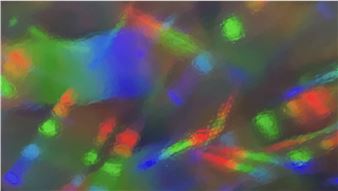Off the Wall
The exhibition also explores the interplay of positive and negative space. You can’t look at George Thiewes’ Points Points Points, for example, a black sculpture hung on a white wall, without considering the relationship of the sculpture’s form to its backdrop – the piece appears to slice the wall.
With Devorah Sperber’s After The Mona Lisa 2, spools of thread appear as an abstracted arrangement of multi-colored blocks/3D pixels — abstracted in that Mona Lisa is upside down and backward. A viewing sphere rotates the imagery 180 degrees back to the correct orientation and reduces the pixels/spools into recognizable images. The sphere offers a different view, accentuating the illusion of sculptural three dimensions as it exists in flat paintings.
Each of the artists in Off the Wall are being featured because three-dimensional works are an important part of their practice. The variety of sculpture in the exhibition demonstrates the striking and inventive possibilities inherent in the form.

Recommended for you
The exhibition also explores the interplay of positive and negative space. You can’t look at George Thiewes’ Points Points Points, for example, a black sculpture hung on a white wall, without considering the relationship of the sculpture’s form to its backdrop – the piece appears to slice the wall.
With Devorah Sperber’s After The Mona Lisa 2, spools of thread appear as an abstracted arrangement of multi-colored blocks/3D pixels — abstracted in that Mona Lisa is upside down and backward. A viewing sphere rotates the imagery 180 degrees back to the correct orientation and reduces the pixels/spools into recognizable images. The sphere offers a different view, accentuating the illusion of sculptural three dimensions as it exists in flat paintings.
Each of the artists in Off the Wall are being featured because three-dimensional works are an important part of their practice. The variety of sculpture in the exhibition demonstrates the striking and inventive possibilities inherent in the form.
















